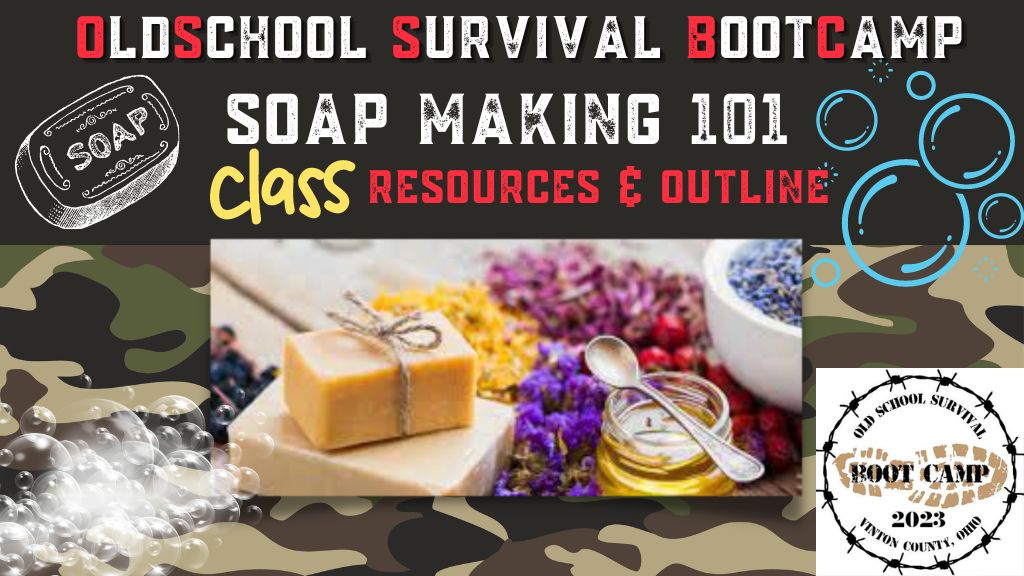Soap Making 101 Class OSSBC
Old School Survival Bootcamp Class Resources and Outline
Soap Making 101
Soap making can be a fun and exciting hobby or business. Very little equipment is needed, however, when working with lye certain safety measures and precautions can ensure not only a great final product but that your life and limbs stay in tact.
Equipment for Soap Making
- Kitchen Scale
- Thermometer
- Immersion Blender (Stick Blender)
- Glass or Heavy duty Plastic Containers, or Stainless Steel for Measuring & Mixing Lye ( do not use aluminum metal, it reacts to the lye)
- Containers for Mixing the Soap Batter (again, stainless steel, plastic or glass)
- Heavy Duty Plastic, wood, or Silicone Spoons & Spatulas
- Gloves & Goggles
- Soap Molds
3 Ways to Make Soap
- Cold Process- soap heats from the inside out and takes 4-6 weeks to cure for use. Stick blended until it hits trace (a thick batter), and poured into a mold. Soapification happens over the next 48 hrs. Better for soaps containing sugar or milk and for making layers or swirls.
- Hot Process- soap heats from the outside in and can be used immediately after hardening. Mixed and heated in the slow cooker, somewhere between 140 degrees F and 176 degrees F. That slow cooker helps that batter go through saponification until the soap reaches gel phase (1-2 hours). Lumpy batter and more rustic looking soap
- Glycerin, melt and pour
Soap Making Terms
Caustic Soda – Another name for Sodium Hydroxide (lye). It is the alkali (base) used in bar soap making
Cure – The time period between making the soap and its use. Generally 4 to 6 weeks. During this time the soap loses water and also undergoes chemical changes.
Gel Phase –If the soap batter is kept warm after pouring into the mould it will warm up so much during the chemical reaction that it becomes translucent and gel like. Colours will generally be more vibrant if your soap reaches gel phase but it is not necessary to create a lovely bar of soap. There are some situations where you would not want gel phase – milk soap is an example as the milk may scorch.
Soda Ash – A powdery white residue (sodium carbonate) that sometimes forms on the surface of soap. It is caused by the sodium hydroxide reacting with the air before it has chance to turn into soap
Superfat – The excess oils left unsaponified in the finished soap. This excess oil contributes to the moisturising qualities of soap.Usually between 5 and 8% in most recipes
saponification is the chemical reaction during the soap-making process in which the building blocks of fats and oils (triglycerides) react with lye to form soap.
The word literally means “turning into soap” from the root word, sapo, which is Latin for soap. The products of the saponification reaction are glycerin and soap.
Soap Making Calculator Oils and fats each have what is called a “saponification value,” which is the amount of lye needed to completely neutralize them into the soap with no lye left over. Each oil has a different value, which is why it’s important to always run soap recipes through a lye calculator. The calculator will help ensure that the ratios of water, oils, and lye are correct and will produce the results you are looking for.
Trace – When you pour the lye water into the oils, the mixture starts to turn slightly cloudy and milky. This is the start of the saponification process, where the lye and oils begin to react and turn to soap. With a few pulses and stirs of the stick blender, it takes on a creamy consistency. This process happens fairly quickly. Before the age of stick blenders, it could take hours for soap to reach trace
Medium trace is next – it has a thin pudding consistency.
Thick trace is the consistency of pudding and holds its shape.
actors that can affect trace:
- Stick blenders bring soap to trace more quickly than stirring by hand. When you’re making soap, alternate between stirring and pulsing the stick blender in short bursts. Once it’s at thin trace, don’t continue blending unless you want to reach medium or thick trace.
- Some fragrance oils accelerate, causing the soap to reach thick trace more quickly. Learn more in the How to Work with Misbehaving Fragrances article.
- Adding fragrances after colorants and other additives gives you more time to work with the soap.
- Some additives affect trace. For instance, clay can absorb water in the recipe and cause acceleration. We recommend mixing those additives with distilled water and then adding them at trace to help slow it down.
- Recipes made with a high percentage of hard oils and butters will reach trace more quickly than soap made with mostly liquid oils. Learn more in the Formulating Cold Process Soap Recipes article.
- Temperature also plays a part. Warmer temperatures speed up trace more than cooler temps. If your design requires a lot of swirls, drop to around 100-110° F.
- Water discounting results in faster trace.
- Increasing the superfat will result in a slower-moving recipe. Learn more about superfatting soap here.
If you are unsure what the difference is, cold process is the age old traditional method, no external heat is used during the process other than to melt the oils. Curing time for your soap is 4 to 6 weeks.
Hot process soap making involves ‘cooking’ your soap which speeds the saponification process up considerably however a cure is still needed albeit I think you can get away with using a it a little sooner.
Cold Process – The Good Bits!
1 Minimal equipment needed, generally just kitchen jugs , a digital thermometer and a cheap household blender plus your chosen ingredients.
2 The option to make multi coloured soap easily
3 A huge variety of techniques are available to produce beautiful patterns and swirls ye
4 The initial making of your soap is relatively quick, less than hour
5 The finished soap is smooth and attractive to look at, a more polished product.
Cold Process – The Bad Bits!
1 There is a 4 to 6 week delay before you can use your finished soap
2 The clearing up is harder, you either deal with caustic soap dishes on the day or leave them somewhere safe until the following day when the soap batter will have turned to soap.
3 Not all scents, particularly essential oils, do well in cold process soap. The initial, extreme alkaline conditions can cause them to morph into something else or disappear.
4 There are some issues such as soda ash appearing on the top of your soap which only occurs in cold as opposed to hot process soaps
5 You need to plan a little further ahead if you want to make soap for seasonal events such as Christmas.

Hot Process – The Good Bits
1 Speed – you can use your soap a little faster although it will still benefit from as long a cure as you can give it.
2 Easy clean up. Just soak your slow cooker and spoons etc in hot water to dissolve soap away
3 Essential oils remain truer in scent as you add them after the cook and they do not have to survive the saponification process.
4 A little less planning for special occasions/events may be needed.
5 Less space needed to store soap while you wait for it to cure. I don’t feel it needs quite the same amount of space and air flow as cold process – it seems a little more hardy in that respect.
6 You can choose your superfat! ie You can choose a really luxurious butter or oil and add it in after your soap is cooked and it will not be turned in to soap but remain free floating which will in turn be extra moisturising for your skin.
Hot Process – The Bad Bits
1 It is not as pretty! It can look a little rough around the edges – aka rustic.
2 It is much harder to do lovely swirls and different colours – it is not impossible but you need to be very experienced, use a slightly different method which is harder to accomplish and add extra ingredients to keep your soap batter fluid – and to be honest it still does not swirl as well.
3 You cannot make such large batches although unless you have a soap business this is not an issue .
4 It is harder to use additives such as milk or fresh vegetable juices as they may burn and go brown.
Soap is created by the chemical reaction of a fatty acid with an alkali.
WARNING! Sodium hydroxide lye is highly caustic and has the potential to burn the skin. Always Add Lye to Water (NEVER add Water to Lye!)
Lye creates an exothermic reaction that causes a dramatic temperature increase so the choice of equipment is extremely important.
Choosing Oils for Soapmaking- a combination of oils usually produces a better all around soap as different oils react differently with the lye and have unique properties which can be detrimental or beneficial.The targets for soap making are hardness, cleansing, bubbly lather, creamy lather, and conditioning.
Ingredients- oils, aka fats, lye, and water
Base oils- Olive Oil, Lard, Tallow, Coconut Oil
- Olive Oil- Can be 100%
olive oil soaps are great for sensitive skin and conditioning. They aren’t as cleansing and don’t provide much of a lather.
Soaps made with 100% olive oil are called pure Castile soaps
- Cococut Oil – Can be 100% if superfatted…provides a lot of lather and soaps made with coconut oil do a great job cleaning. On the downside, soaps made with only coconut oil are said to be drying. That’s why it isn’t used alone in most soap recipes. You can , however, counteract that by superfatting by a large percentage, even to around 20%. (Superfatting is when you add more oil/fat than what is needed to make soap so that some unreacted oil remains in your soap.)
- Tallow – high in vitamins like A, D, E, and K. Vitamin E is especially important for aging skin…helps to produce rich, creamy lather that is gently cleansing
- Lard- creamy and stable lather. In addition, it has mild moisturizing qualities that will prevent the soap from drying the skin. Lard soap is highly compatible with the structure of the human cells
Liquid Oils
Castor oil can make a soap more easily dissolved in water. It also helps boost and extend lather time. That’s why it’s a great addition to shave soaps.If used at too high a percentage (over 10%), though, it can make a bar of soap feel sticky. For most soaps, using up to around 5% is a good amount to use.
Jojoba, avocado, sunflower oils, etc
Many liquid oils can be used up to 10-15% in soap recipes for medium lather and mild cleansing. When used in higher concentrations, the bar of soap can become too soft or the soap or can even go rancid prematurely.
Jojoba oil is really a liquid wax, but it mostly behaves like the liquid oils in soap making. It is more stable than them against rancidity.
When using liquid oils, it generally takes longer to reach trace during soap making. It also may take longer to harden up enough to unmold
Butters (Shea, Cocoa, Mango)
Butters like shea butter, cocoa butter, and mango butter tend to help make hard bars of soap with stable lather. Using them up to around 20% of a soap recipe is a good amount to shoot for, but they can be used in higher amounts.
Waxes
A tiny amount of wax, such as beeswax, can also help harden the soap. Too much, though, can completely kill the lather and make the soap sticky. Around 1-2% of the oil portion of the recipe is a good maximum amount to add.
Combining oils
To get the benefits of several different oils in a way that complement each other, most soaps use a combination of a variety of oils.
Liquid oils are used for their moisturizing and/or conditioning properties. They tend to make mild soaps, but if used alone, they can make bars of soap that are too soft. Olive oil is the exception and can make a hard bar of soap, albeit one that doesn’t lather much.
Some people love pure Castile soaps for their mildness. Other people hate them and say they are too slimy and don’t lather.
To help harden the soaps, increase their lather, and improve their cleansing ability, hard oils are added to the soaps. If you are using olive oil as the main liquid oil, only a small amount of hard oil is needed to improve the qualities of the soap. Otherwise, it’s good to shoot for at least 50% of the oils to be solid oils.
Lye– (either sodium hydroxide or potassium hydroxide) is required to create soap)
You can give it a go at making your own wood ash lye, potash, there are several tutorials online. I tired once but was unsuccessful in making a strong enough liquid but if you are willing to give it a go, just make sure you use hard wood for your wood ash.
Sodium hydroxide, aka caustic soda makes for a more reliable and hard soap. You may be able to find 100% caustic soda in the plumbing secition of Lowes or Home Depot. I buy sodium hydroxide online.
Steps for making soap
1. Find a recipe online or calculate your own. There are several sites online that will help you calculate a good recipe of you are brave enough to experiment. I started with a base of lard, which I had in abundance and kept putting in different percentages of two other oils, Coconut and Olive, until all the various characteristics of a good soap were in the desired range. You can read more about how each oil contributes to attributes like lather, cleansing, or moisturizing on websites like soapcalc.net
Suit up! Lye is caustic and can burn skin. Gloves and Glasses are a must!
2. Once you have a recipe it’s time to weigh your ingredients. This is where a good kitchen scale is invaluable. Weighing you ingredients yields more consistent results than measuring by volume.
3. You can put your container on the scale the hit the Tarre button which zeroes out the scale so you know how much you are putting into the bowl
4. Add your lye to the water- never add water to the lye. The lye will get very hot and gas off. Stir for a few minutes and set outside if possible. Your lye water will take a long time to cool down enough to add to your oils. If you want to speed this up, place the container ( a glass ½ gallon jar works great) into a larger container of cold water.
5. Melt oils to your desider mixing temp. It is helpful but not necessary to have your lye and oils within 10 degrees. Most recipes will tell you to lower the lye temp to 95-110 degrees. For recipes including lard, 125-130 will work. The hotter the temps, the quicker you will reach trace
6. Once cooled to desired temp, add the lye to your oils and stir. Use an immersion blender in spurts of 30 seconds to a minute, then stir with a spatula or whisk
Your mixture should begin to emulsion, you’ll know you are getting somewhere when you don’t see separations of oil.
7. Trace-, this is the time you want to add any fragrance or essential oils
Trace is the point at which the soap has thickened and blended enough to have formed a stable emulsion. When you pour the lye water into the oils, the mixture starts to turn slightly cloudy and milky. This is the start of the saponification process, where the lye and oils begin to react and turn to soap. With a few pulses and stirs of the stick blender, it takes on a creamy consistency. This process happens fairly quickly. Before the age of stick blenders, it could take hours for soap to reach trace!
Light trace is a solid color and the consistency of thin cake batter.
Medium trace is next – it has a thin pudding consistency. It takes about 1-2 minutes to reach. When you remove the stick blender and drizzle soap on top, you’ll notice thin streaks stay on the surface.
Thick trace is the consistency of pudding and holds its shape.
At any point after the emulsification process, you can pour your soap into your molds
8. Cover and insulate the mold.
This keeps the soap warm so that it can go through gel phase and finish saponifying. Leave for 24-48 hrs. If you notice cracking, uncover as your soap is too hot
9. Uncover and cut your soap. Your soap will be easier to cut if you do this within the first couple days. Let cure for 3-4 weeks, turning ever so often.
Link to soap calculator
http://soapcalc.net/
https://www.soapqueen.com/
| SoapCalc © | Recipe Name: Leah’s Best Oatmeal Soap | New Print Recipe |
Total oil weight64 ozWater as percent of oil weight38.00 %Super Fat/Discount5 %Lye Concentration27.070 %Water : Lye Ratio2.6941:1 | Sat : Unsat Ratio47 : 53Iodine52INS156Fragrance Ratio0.5Fragrance Weight2.00 oz |
| Pounds | Ounces | Grams | |
| Water | 1.520 | 24.32 | 689.46 |
| Lye – NaOH | 0.564 | 9.03 | 255.92 |
| Oils | 4.000 | 64.00 | 1,814.37 |
| Fragrance | 0.125 | 2.00 | 56.70 |
| Soap weight before CP cure or HP cook | 6.209 | 99.35 | 2,816.44 |
| # | √ | Oil/Fat | % | Pounds | Ounces | Grams |
| 1 | Coconut Oil, 92 deg | 20.31 | 0.813 | 13.00 | 368.54 | |
| 2 | Lard, Pig Tallow Manteca | 57.81 | 2.313 | 37.00 | 1,048.93 | |
| 3 | Olive Oil | 21.88 | 0.875 | 14.00 | 396.89 | |
| Totals | 100.00 | 4.000 | 64.00 | 1,814.37 |
Soap Bar QualityRangeYour RecipeHardness29 – 5444Cleansing12 – 2214Conditioning44 – 6950Bubbly14 – 4614Creamy16 – 4830Iodine41 – 7052INS136 – 165156 | Lauric10Myristic4Palmitic21Stearic9Ricinoleic0Oleic43Linoleic7Linolenic0 |
| Additives | Notes STir in ¾ cup soap near the end, once blending is done |
Using your lard soap To Make Homemade Laundry Soap
- 1 box Borax
The main additive in laundry soap, 20 Mule Team Borax™, helps control hard water, cleans clothes more thoroughly, and prevents damage. - 1 box Washing Soda
This ingredient is highly alkaline and helps the soap be more effective at cleaning clothes and loosening up stubborn stains. - 3 Bars of Soap
How to Make Your Own Laundry Soap
- 1. Finely grate the 1 Bar of Soap into container, I use a food processor with a grater attachment.
2. Combine Ingredients - 3. Store in closed container
- 4. Add in1- 2 tablespoons of laundry soap per medium load and enjoy fresh, clean clothes.













